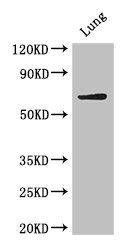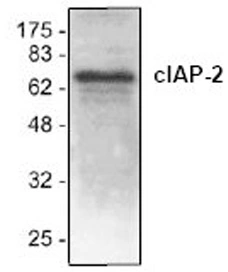cIAP2 antibody [C1C3]
GTX113128
ApplicationsWestern Blot, ImmunoHistoChemistry, ImmunoHistoChemistry Paraffin
Product group Antibodies
TargetBIRC3
Overview
- SupplierGeneTex
- Product NamecIAP2 antibody [C1C3]
- Delivery Days Customer9
- Application Supplier NoteWB: 1:500-1:3000. IHC-P: 1:100-1:1000. *Optimal dilutions/concentrations should be determined by the researcher.Not tested in other applications.
- ApplicationsWestern Blot, ImmunoHistoChemistry, ImmunoHistoChemistry Paraffin
- CertificationResearch Use Only
- ClonalityPolyclonal
- Concentration0.67 mg/ml
- ConjugateUnconjugated
- Gene ID330
- Target nameBIRC3
- Target descriptionbaculoviral IAP repeat containing 3
- Target synonymsAIP1, API2, CIAP2, HAIP1, HIAP1, IAP-1, MALT2, MIHC, RNF49, c-IAP2, baculoviral IAP repeat-containing protein 3, IAP homolog C, RING finger protein 49, RING-type E3 ubiquitin transferase BIRC3, TNFR2-TRAF signaling complex protein, TNFR2-TRAF-signaling complex protein 1, apoptosis inhibitor 2, cellular inhibitor of apoptosis 2, inhibitor of apoptosis protein 1, mammalian IAP homolog C
- HostRabbit
- IsotypeIgG
- Protein IDQ13489
- Protein NameBaculoviral IAP repeat-containing protein 3
- Scientific DescriptionThe protein encoded by this gene is a member of a family of proteins that inhibits apoptosis by binding to tumor necrosis factor receptor-associated factors TRAF1 and TRAF2, probably by interfering with activation of ICE-like proteases. The encoded protein inhibits apoptosis induced by serum deprivation but does not affect apoptosis resulting from exposure to menadione, a potent inducer of free radicals. The amino acid sequence predicts three baculovirus IAP repeat domains and a ring finger domain. Transcript variants encoding the same isoform have been identified. [provided by RefSeq]
- Storage Instruction-20°C or -80°C,2°C to 8°C
- UNSPSC12352203
References
- Leu JS, Chen ML, Chang SY, et al. SP110b Controls Host Immunity and Susceptibility to Tuberculosis. Am J Respir Crit Care Med. 2017,195(3):369-382. doi: 10.1164/rccm.201601-0103OCRead this paper
- Huang YT, Chen YY, Lai YH, et al. Resveratrol alleviates the cytotoxicity induced by the radiocontrast agent, ioxitalamate, by reducing the production of reactive oxygen species in HK-2 human renal proximal tubule epithelial cells in vitro. Int J Mol Med. 2016,37(1):83-91. doi: 10.3892/ijmm.2015.2404Read this paper







